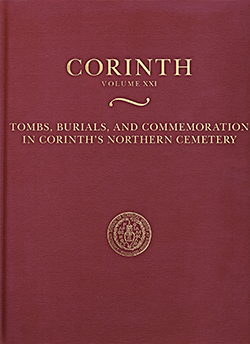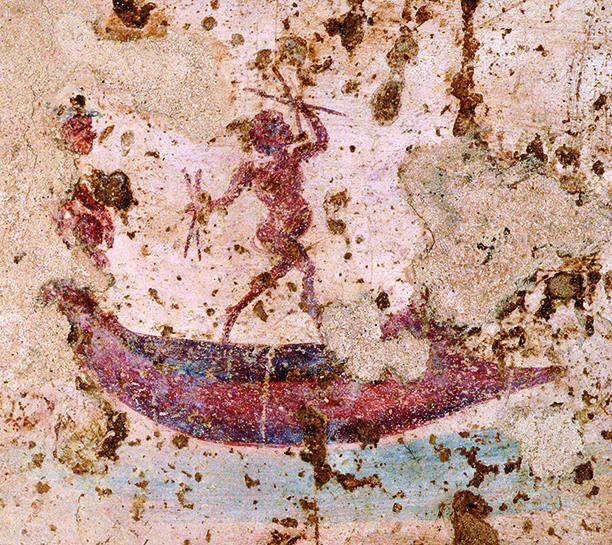Tombs, Burials, and Commemoration in Corinth’s Northern Cemetery: An Interview with Kathleen Warner Slane

The American School of Classical Studies at Athens is pleased to announce the publication of Tombs, Burials, and Commemoration in Corinth's Northern Cemetery (Corinth XXI) by Kathleen Warner Slane. Kathleen Warner Slane is Professor Emerita of Art History and Archaeology at the University of Missouri, where she specialized in Roman Art and Archaeology.
Rescue excavations were carried out along the terrace north of Ancient Corinth by Henry Robinson, the director of the Corinth Excavations, and the American School of Classical Studies at Athens on behalf of the Greek Archaeological Service in 1961 and 1962. They revealed 70 tile graves, limestone sarcophagi, and cremation burials (the last are rare in Corinth before the Julian colony), and seven chamber tombs (also rare before the Roman period). The burials ranged in date from the 5th century B.C. to the 6th century A.D., and about 240 skeletons were preserved for study. This volume publishes the results of these excavations and examines the evidence for changing burial practices in the Greek city, Roman colony, and Christian town.
Q: What is Corinth's northern cemetery? When was it first in use?
A: What is known as the North Cemetery of Corinth lies about 1 km northwest of the theater and was first excavated in 1915 and 1916 by Bert Hodge Hill and William Bell Dinsmoor. In 1928–1930 T. Leslie Shear excavated 530 graves and 54 deposits in the same area; they ranged in date from Middle Helladic and Geometric into Hellenistic and were published in 1964 as Corinth XIII: The North Cemetery. In the years since then, excavations by the School and by the Greek Archaeological Service for the National Highway and the high-speed railroad have made it clear that the southern edge of the plain below the terrace was a cemetery that stretches for a couple of kilometers from west to east. There are other burial grounds to the east, south, and west of the city, but this seems to have been the greatest concentration of graves from the Middle Bronze Age into late antiquity, at least. The excavations of 1961 and 1962, which were actually partway up the face of the terrace on the 45 m contour, seem to define the southern edge of the burials in the plain. I called it the northern cemetery (not capitalized) to distinguish it from the earlier excavation, which is a very small area but very widely cited.
Q: As part of this publication you reconstructed excavations from 1961 and 1962 in the present, relying on the excavation notebooks, drawings, photographs, and objects themselves. What were these excavations? How did you go about doing this?
A: The first excavation along the terrace was in 1961 and 1962 when an aqueduct was built to bring water from Lake Stymphalos to Corinth. The 1961 excavation was of a cluster of tombs and graves in what is now the curve of the road from the village down to the plain. The 1962 excavations "followed the bulldozer," which revealed a well-preserved tomb with monumental paintings to the west of the Asklepieion and a long, irregular stretch of tombs, burials, and deposits for over a kilometer east of the 1961 excavations. We used an aerial photograph from 1963, which shows the trench excavated by the bulldozer, and the information in the notebooks to locate where the tombs, graves and deposits had been (and James Herbst was able to verify the positions of the still-standing tombs by GPS). The rest was just compiling, sifting, and integrating the extensive descriptions and drawings in the excavation notebooks with the photographs, objects, and bones—and resolving any discrepancies. Hindsight, plenty of time, and more knowledge of the objects and skeletal material allowed me to place the material in a wider perspective.

Grave and chamber tomb from the 1962 excavations
Q: These excavations revealed 70 tile graves, limestone sarcophagi, and cremation burials from the 5th century B.C. all the way through to the 6th century A.D. What do these burials reveal about changing burial practices in Corinth during this period?
A: Briefly, that the Classical and Hellenistic burial practices differed from those of the Roman colony and that they changed again in the late 4th–5th centuries. This is visible in the orientation of the burials, perpendicular to the terrace in the earlier period and parallel to it with head to the east in the Roman period; some of the latest burials were placed with heads to the west in what would become common Christian practice. Greek burials are normally single interments, Roman ones often have several associated corpses, and the latest are multiple burials of 10–20 people. There is also a change in what accompanied the burials, from the pitcher and lamp placed within a Classical or Hellenistic grave (for sustenance?) to detritus from the funeral in the later periods (for instance, the unguentaria used for final anointing, or a cooking pot and lamp left on the cover of the sarcophagus before the grave shaft was filled in). Many of the Roman and late Roman graves lacked any kind of grave goods, apparently a matter of practice rather than wealth.
Q: What is the Robinson “Painted Tomb" discussed in this publication? Why is it important?
A: The Robinson Painted Tomb was excavated by Rebecca Robinson in 1962. It is a two-chamber tomb excavated into the face of the terrace and the walls were once decorated with geometric wall paintings and conventional funeral iconography—plus the rustic paintings now on display in the Roman gallery of the Corinth Museum. It's called the Robinson Painted Tomb because there is another, very similar one, the Shear Painted Tomb, which was excavated by Shear in 1930 and published the same year ("Excavations in the North Cemetery at Corinth in 1930," AJA 34, 1930) and now by Mary Walbank ("A Roman Corinthian Family Tomb and Its Afterlife," Hesperia 84, 2015). The paintings were left in that tomb and are no longer preserved. Another painted tomb has been recently excavated by the Archaeological Service and moved near the entrance to the museum, where they hope eventually to open it to the public.

Detail of a wall painting from Robinson's Painted Tomb
Q: About 240 skeletons from this excavation were preserved for study. What else was found in these burials? What can these items reveal about the Greek city, Roman colony, and later Christian town?
A: In 1962 it was unusual to record and preserve so many inhumations and cremations. Ethne Barnes' study recorded a great deal about age, gender, disease, and signs of occupational stress on the human bones—and also a surprising lack of child burials. It was very important that she also considered the disposition of the burials and that the study was closely integrated with the stratigraphic examination of the burials and the objects; we would have learned much less if the bone study had simply been assigned to a "scientist" as though it had no connection to the graves (a common mistake of archaeologists). David Reese's study of the animal bone, whether found mixed with the human bones or found separately, revealed that it probably has little to do with the burials. Probably the second lesson we learned over the 40 years between excavation and examination is that, unlike pottery, bone is organic: it decays badly when stored in covered or uncovered cardboard boxes in a non-humidity-controlled environment. That's going to be a headache for directors who have to find a lot of better storage space.
Q: You spend a portion of the book focusing on the architecture of the chamber tombs in the northern cemetery. How does this play into our understanding of Corinth and the cemetery?
A: Most of the chamber tombs found in Corinth are a phenomenon of the Roman period, when associated burials were the norm. Whether they are rock-cut or built, they share sizes, plans, and layouts, making it clear that it's the interior space that's most important. Furthermore, none of the tombs in this study could really be called a "monumental tomb," which serves a different purpose. The plans tell us about how the body was laid out (there were pillows in the cists), that most tombs privileged the place of interment opposite the door, that cremations are often secondary (subsidiary) to inhumations rather than being earlier, that no separate provision was made for children. We also learn about local variation. For instance, these tombs all have cists parallel to the wall, whereas the tombs on the Koutsongila Ridge at Kenchreai have loculi perpendicular to the wall—and a tomb on the eastern outskirts of ancient Corinth has both. It also has a vestibule with a bench on three sides, like the Robinson and Shear Painted Tombs and all the tombs at Kenchreai. On the other hand, there are also similarities and differences with contemporary chamber tombs on Crete, Sicily, and Cyprus, and a few elsewhere as well. One of the most interesting elements is the biclinium found in Robinson's Painted Tomb. The tomb on the eastern edge of Corinth that I just referred to has a triclinium. Such couches were used for commemorative occasions (at least for toasts, perhaps for dining); they occur in the cemeteries of Ostia, making a very strong link between Corinth and central Italy, but one has also been found on Mount Scopus in Jerusalem. The masonry techniques of some of the tombs include poured concrete vaults that show a good knowledge of developments in concrete construction in central Italy.

Roman chamber tomb at Hexamilia from the 1962 excavations
Q: What scholarship had been done on these tombs and burials previously?
A: Between 1962 and 1964 Henry Robinson published preliminary reports in Archaiologikon Deltion, Archaeological Reports, and the Bulletin de correspondance héllenique, including a plan of the painted tomb and its paintings. Those reports have been noted in some general surveys of Roman tombs. The skeletal material was previously studied by Peter Burns and by Sherry Fox (Leonard) and some of the pottery by me, all in our dissertations. Joseph Rife ("Death, Ritual and Memory in Greek Society during the Early and Middle Roman Empire," diss. 1999) and C. Flämig (Grabarchitektur der römischen Kaiserzeit in Griechenland, 2007) included the published tombs in broader corpora of tombs in the Corinthia or in Greece. While this volume was in press I published an article on the architecture ("Remaining Roman in Death at an Eastern Colony," JRA 25, 2012).
Q: What questions still remain following the publication?
A: This is only a beginning. I hope the volume will stimulate discussion and make us look again and reconsider many of the assumptions we make about graves and burials. I also hope it will encourage scholars in Greece to look outward and diachronically, and encourage scholars working elsewhere to include Greece in their studies.
Q: What has your experience with the ASCSA been?
A: I was a regular member in 1973–1974 and participated in the training session at Corinth; I have been an associate member of the School almost every year since then. I wrote my dissertation on Roman fine-wares imported to Corinth, several articles for Hesperia, and Corinth XVIII.2 on the Roman pottery and lamps from the Sanctuary of Demeter and Kore. I was a member of the Managing Committee from 1981, served on or chaired several committees, and will finish my last committee assignment (IT Committee) next year.
Q:What are you working on now?
A: I'm writing another Corinth volume, which I expect will be a digital volume, on the Roman pottery and lamps from the 1981–1990 excavations east of the Theater. I'm also finishing the editing of a volume on the Cosa amphoras for the American Academy in Rome, which will be published by the University of Michigan press.